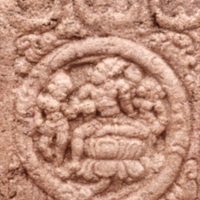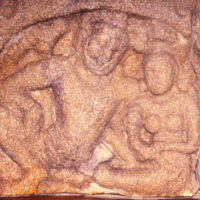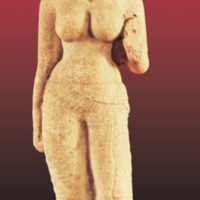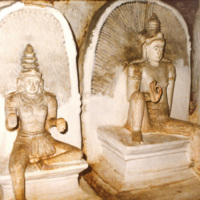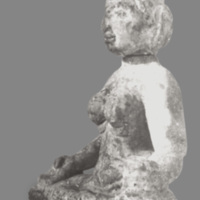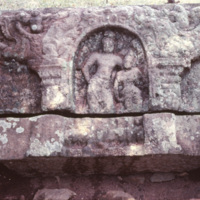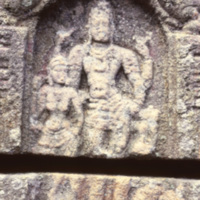Main Menu
AORC Libraries
Browse Archive Items (20 total)
Divine consorts
Description: The two females in the company of an unidentified male god carved on one of the pillars at the Atadage temple, Polonnaruva, Sri Lanka may also fit into the category of divine consorts (ca. 11th-12th century A.D.).
Contributor: Co-Author: Seneviratna, Harsha
Collection: Women in Sri Lankan Sculpture and Painting
Seated woman
Description: This single female carved in a niche, among the stone reliefs of the Isurumuniya Museum, Anuradhapura, Sri Lanka, can be dated between the 6th and 7th century A.D. on stylistic grounds.
Contributor: Co-Author: Seneviratna, Harsha
Collection: Women in Sri Lankan Sculpture and Painting
Consort of Bodhisattva
Description: This couple is carved within a stone niche, is in the museum at the Isurumuniya temple, Anuradhapura, Sri Lanka. The four-armed male figure is either a god or a Bodhisattva and the consort has on her lap a figure which has not been satisfactorily identified. Stylistically, this relief carving may be dated to the 6th to the 7th century A.D. period.
Contributor: Co-Author: Seneviratna, Harsha
Collection: Women in Sri Lankan Sculpture and Painting
Female consort
Description: Interpreted by some as a royal group and by others as a divine family, this bas-relief carved on hard stone is in the museum at the Isurumuniya temple, Anuradhapura, Sri Lanka. Central to the composition is the male figure and the female consort plays a supporting role even in a literal sense. A younger female is tucked behind in a still more subordinate position. It is dated between the 6th and 7th centuries A.D. by museologists.
Contributor: Co-Author: Seneviratna, Harsha
Collection: Women in Sri Lankan Sculpture and Painting
Headless image of a Buddhist Goddess
Description: This head-less image of limestone is of a Buddhist goddess. The gesture of holding her garment at the waist is unusual. Dates between the 6th and 7th centuries A.D. have been suggested by art historians.
Contributor: Co-Author: Seneviratna, Harsha
Collection: Women in Sri Lankan Sculpture and Painting
Torso of a Buddhist goddess
Description: Among those sculptures which have been tentatively identified as consorts of Bodhisattvas or else female goddesses within the scheme of Buddhist worship, is this fragmentary yet exquisite limestone torso of a life size image. Notable is the simple attire and the lack of ornamentation already noticed in respect of the majority of Buddhist goddesses. A tiny hole in the centre of her left palm suggests that she held something in her hand. A date between the 6th and 7th centuries A.D. has been…
Contributor: Co-Author: Seneviratna, Harsha
Collection: Women in Sri Lankan Sculpture and Painting
Tara, consort of Avalokiteśvara
Description: Today, this is the only instance of Tara worshipped as the consort of Avalokitesvara. Known as Biso bandara, her image, made of stucco, is housed together with the Bodhisattva in a single shrine. The sculptures seem to belong to the Kandyan period - 1529-1815 A.D.
Contributor: Co-Author: Seneviratna, Harsha
Collection: Women in Sri Lankan Sculpture and Painting
Terra-cotta image of Tara
Description: That the goddess Tara finds a place in what is called the poor man’s art, can be seen from this terra-cotta image, said to be in the Archaeological Museum at Trincomalee, Sri Lanka. This slide was made from a photograph available in the Department of Archaeology in Colombo. The image probably dates to the Mahayana phase of Sri Lankan sculpture (ca. 7th to the 12th century A.D.).
Contributor: Co-Author: Seneviratna, Harsha
Collection: Women in Sri Lankan Sculpture and Painting
Stone relief, consort of Bodhisattva
Description: An image of Tara from the Vijayarama reliefs. The images in these reliefs are sometimes identified as Hindu deities. However, as they exist in a Mahayana (Buddhist) temple, the identification of Bodhisattvas and Taras seems justifiable. Copper plaques found in the precincts have invocations to the goddess Tara and the script is Sinhalese of the 8th century A.D. This is one of four reliefs at the Vijayarama Temple.
Contributor: Co-Author: Seneviratna, Harsha
Collection: Women in Sri Lankan Sculpture and Painting
Stone relief of consort of Bodhisattvas
Description: Bodhisattvas and their consorts form the subject of a number of reliefs round the stone basement walls of the Vijayarama temple at Anuradhapura, Sri Lanka, a centre of Mahayana worship of the 8th century A.D. In all these reliefs, the 4-armed Bodhisattva images are given pride of place and the female companions or Taras occupy supporting roles. Copper plaques found in the precincts have invocations to the goddess Tara and the script is Sinhalese of the 8th century A.D. This is one of four…
Contributor: Co-Author: Seneviratna, Harsha
Collection: Women in Sri Lankan Sculpture and Painting



